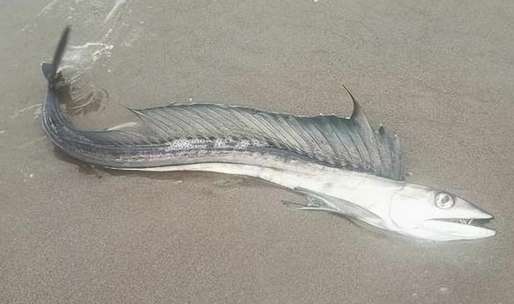At the beginning of May, many people went to the beach in Oregon State Park to walk and jog early in the morning, enjoying life in the morning sun and sea breeze. However, a fishy smell of seafood flowed into people's nostrils along with the sea breeze. When everyone followed the smell, they soon saw a strange fish that was 1.5 meters long.

I saw this strange fish The fish was obviously dead and gave off an "intoxicating" smell, but its skin still had a silvery sheen. Its head is much wider than its body, and its huge eyes and dagger-sharp fangs make it look like the big head is spliced onto the body of a hairtail, but this "hairtail body" has a tall, sail-like dorsal fin. Such a structure may be very powerful in the water, but humans on the shore find it strange no matter how they look at it.
In this regard, Oregon Park Management stated: In recent weeks, several such strange fish have been found on beaches from Nehalem southward to Bandon. They are long-nosed sail lizards. fish, it is not known why they washed ashore. But one lucky guy was found alive and has been released.
Alepisaurus ferox
The Alepisaurus ferox, commonly known as the female dog fish or the Alepisaurus ferox, is an angelfish in the family Alepisaurus family. The type species of the genus Fish. They are distributed in most tropical and subtropical waters, including the Pacific, Indian Ocean, Atlantic Ocean, Taiwan Island, and the South China Sea, East China Sea and other waters.
The long-nose sail lizard fish can reach 1.5-2 meters, and their sail-like fins extend almost to the entire body. This design is both flexible and can reduce water resistance, coupled with its gelatinous muscles to provide Their explosive power allows them to swim at high speeds in the water; they are hermaphrodites, possessing both female and male sexual organs, and will choose their gender for reproduction according to different circumstances; their lower jaw teeth are slightly larger and sharper than their upper jaws, so they are With one bite, the prey will basically "say" to the world "Goodbye".

They generally inhabit the twilight zone 1,000 meters below the sea level. They are migratory fish and have the characteristics of vertical movement day and night. They lie dormant in the deep sea area during the day and begin to slowly rise to the near surface to search for food at night. Food. They are quite greedy and will eat basically any animal they can swallow. Their feeding habits are quite complex. Researchers have found various fish, cephalopods, molluscs, coelenterates, and crustaceans in their intestines. animals are even often found feeding on their smaller counterparts.
Although they are greedy, they are also very smart. They understand that at the front where the cold and warm currents meet, the water in this area will rise after the intersection. The passing animals will take the initiative to avoid accidents. Reduce the speed, and the long-nosed sail lizard fish that has adapted to this feeling can take the opportunity to hunt.
Their ultra-complex feeding habits make them a favorite of marine scientists, because various deep-sea species can be found in their stomachs, which is of great help to scientists in their research on deep-sea species.
Why are there frequent strandings?
Why do they, which have long lived in deep water, wash up so frequently on Oregon beaches in recent times?
Daniel J. Kamikawa, a fisheries research biologist at the National Oceanic and Atmospheric Administration (NOAA) Northwest Fisheries Science Center, said in an interview that he has found no precedent for frequent strandings of the longnose lizard fish. , proving that such situations are uncommon.
But he believes that although it is uncommon, it is not surprising. Because strandings of many deep-sea species make the news, without coordination to quantify sightings, once the initial storm subsides, there is enough time before the next stranding is completely forgotten about and then becomes news again.
As for why they wash up on the beach, Daniel J. Kamikawa has three conjectures. First, the stranded lizard fish was injured or sick and could not effectively control itself, so it was washed ashore; second, the storm brought the unfortunate fish ashore; and finally, there was a phenomenon called temperature shock: the fish suddenly Exposure to water that is much colder than its normal temperature range can cause disorientation and even shock and loss of control of the body.

But these are just It is speculated that the reason why these long-nosed sail lizards were washed up has not yet begun to be studied. Oregon State Parks is currently asking the public to take photos of stranded Sailfish they encounter and call them for disposal, hopefully in the future.Determine the mystery of their stranding.